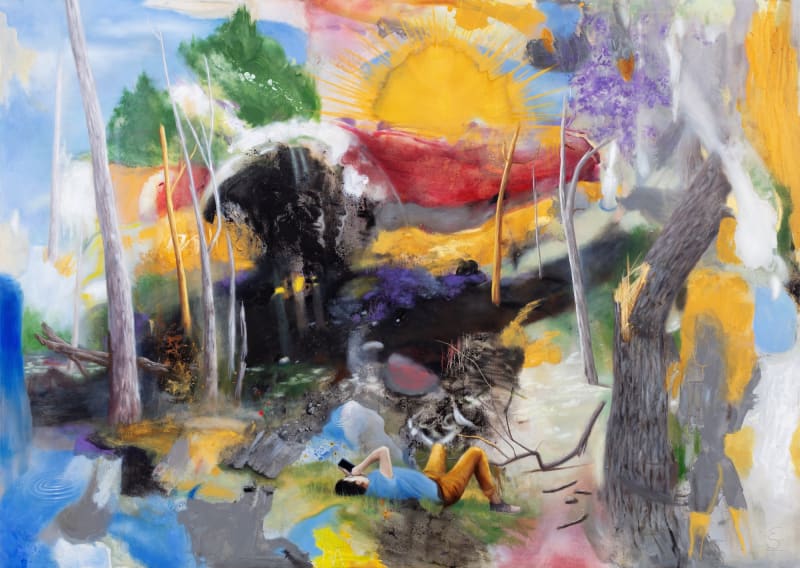Welcome to the Void
Elías Santis's paintings are disconcerting to me. His stylistic mix reminds me of a particular sum of things: a verism that owes as much to the primitive painters of the Renaissance as to photography; a surreal context close to magical realism; the exquisite corpses or ambitious compositions of Guillermo Pérez Villalta or the scenarios of Max Gómez Canle. All examples share with our artist a dose of eccentricity that is alien to calculation. Santis's palette, moreover, is nourished by the serene naturalism of his most archaic sources, as well as by the expressionism of the beginning of the century. Earth tones, siennas and yellows are contrasted, diluted or confused with reds, magentas and a blue that takes on the status of a character.
Santis paints canvas and paper in a chromatic and playful way, as he did as a child, guessing at shapes hidden in the contours of the low, dense clouds of his native Buenos Aires. The artist creates a chromatic field from which the shapes emerge. The process is, of course, reminiscent of automatic painting, but the method does not pretend to be a pure or immediate transcription of the processes of the unconscious, but rather a trigger of experiences - very personal, very sensitive - through colour and the suggestions of the splotch. Far from being a simple inventive tool in the tradition of Da Vinci or Victor Hugo, the process is a way of connecting with his own psyche. A test of colours and patches, handmade and self-induced, which also determines the chromatic harmony of the piece. Colour, psychism and spirituality.
These works by Santis, in an era marked by political art with the vocation of catechesis, are risky because of the extreme singularity of his agenda: what we see appears as a sincere homage to affection, to the shelter of family life, to communities of friends. A private optimism that can discreetly conceal the current forms of coexistence. If the tranquillity in which the characters seem to dwell, if their ability to indulge in pleasurable leisure only seems to exist in a colourful phantasmagoria, we would be dealing with pure reverie. Thus, the image of a father with his son, reminiscent of Oscar Bony in La Familia Obrera, seems to be situated in a place that could be that of memory or fantasy, and it seems clear - either way - that this world, marked by knowledge inscribed in the sensitive domain of affective relations, is a utopia or a possibility that has already been extinguished.
Far from embodying a postmodern hedonism or the enlightened and banal pastime of multiple references, his colourful, sometimes playful proposal is, on the contrary, faithful to a handful of convictions - based on a very personal mythology, a creed of his own - the artist articulates his imaginary as if it were a series of stories, parables whose purpose was to illustrate a spiritual path. This was the purpose of Klee or Kandinsky, of Tamayo or Remedios Varo.
Yes, Santis is a believer, but of a heterodox and private faith. These works are not: they do not intend to become revealed truth. But it is how he constructs a reading of the way he thinks that allows him to put together the script of his work. What was normal at the beginning of the 20th century, Mondrian's theosophy, Hilma af Klint's theosophy, and even Johannes Itten's Mazdakism seem strange to us today. Discourses that do not fit into the perfectly packaged patterns of contemporary art. Among these artists from the beginning of the century, as well as our own: Torres García, Xul Solar, and Tarsila do Amaral, the canons of Western rationality were questioned, denied, and fused. However pertinent these ideas may seem to us today; their importance lies in their ability to push artists into boundaries that would have been unthinkable without their presence or help.
Without committing himself to a formalised philosophy or belief, Santis shows his interest in the I-Ching and light as physical and spiritual phenomena. From there, and from an intuitive relationship with his pictorial means, the artist constructs a work that transforms his existential and even eschatological questions into fascinating mental landscapes.
César Gabler, artist and curator.
August 2023.

